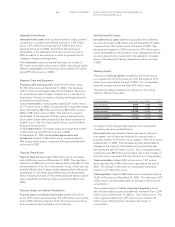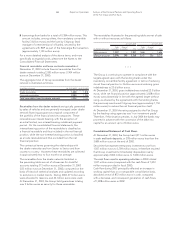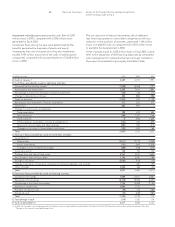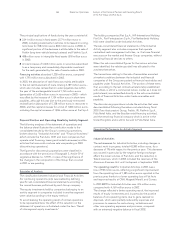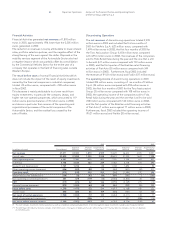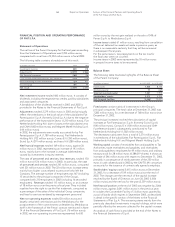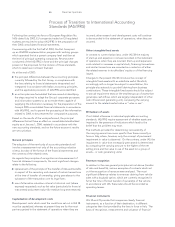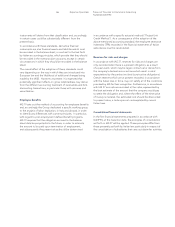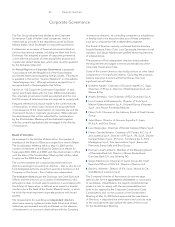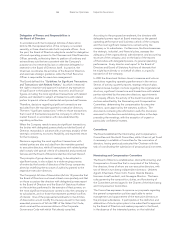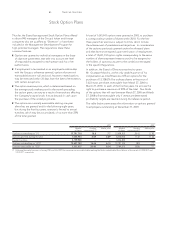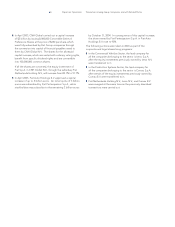Chrysler 2003 Annual Report Download - page 36
Download and view the complete annual report
Please find page 36 of the 2003 Chrysler annual report below. You can navigate through the pages in the report by either clicking on the pages listed below, or by using the keyword search tool below to find specific information within the annual report.
35 Report on Operations
Following the coming into force of European Regulation No.
1606 dated July 2002, EU companies traded on EU regulated
markets are required to adopt IAS/IFRS in the preparation of
their 2005 consolidated financial statements.
Commencing with the first half of 2003, the Fiat Group set
up an IAS/IFRS implementation program with working groups
which operated first at a parent company level and then at
the level of principal operating companies. Reviews were
conducted of the IAS/IFRS in force and the principal changes
present in the proposals for the revision of those standards,
which to date have not been finalized.
As at the end of 2003:
❚the principal differences between the accounting principles
currently followed by the Fiat Group, in compliance with
the laws relating to financial statements interpreted and
integrated in accordance with Italian accounting principles,
and the applicable provisions of IAS/IFRS were identified;
❚an action plan was formulated that was aimed at identifying
the steps required to adapt the Group’s corporate processes
and information systems so as to render them capable of
supplying the information necessary for the preparation of the
Group’s 2005 consolidated financial statements in accordance
with IAS/IFRS, and to permit the processing of the information
related to 2004, to be presented for comparative purposes.
Based on the results of the work performed, the principal
differences that will have an effect on consolidated stockholders’
equity as at January 1, 2004, restated in accordance with the
new accounting standards, and on the future economic results
are set out below.
General principles
The adoption of the new body of accounting standards will
involve a reassessment not only of the accounting valuation
criteria, but also of the format of the financial statements and
the contents of the related notes.
As regards the principles of recognition and measurement of
financial statement components, the most significant changes
relate to the following:
❚replacement of the principle of the transfer of risks and benefits
in respect of the recording and reversal of certain transactions
at the time of transfer of ownership, giving prevalence to the
substance of the transaction over its legal form;
❚use of alternative valuation criteria to historical cost (where
expressly requested), such as fair value (particularly for financial
instruments) and present value (for medium-long term reserves).
Capitalization of development costs
Development costs which meet the conditions set out in IAS 38
must be capitalized, whereas at present they are for the most
part recognized in the statement of operations when they are
incurred; other research and development costs will continue
to be recorded in the statement of operations, when they are
incurred.
Other intangible fixed assets
In contrast to current Italian laws, under IAS 38 the majority
of start-up and expansion costs are recorded in the statement
of operations when they are incurred. Start-up and expansion
costs related to increases in capital stock, financing transactions
and similar transactions are recorded as a reduction of either
the related reserves in stockholders’ equity or of the financing
issued.
Changes to the present IAS 38 introduce the concept of
intangible fixed assets with an indefinite useful life which,
accordingly, will no longer be subject to amortization; this
principle also extends to goodwill deriving from business
combinations. These intangible fixed assets should be subject
to annual impairment tests on the smallest group of assets that
generates cash inflows which are largely independent of other
cash inflows (cash generating unit), comparing the carrying
amount to the related market value or “value in use”.
Writedown of assets
If not stated otherwise in individual applicable accounting
standards, IAS/IFRS require assessment of whether assets are
impaired in the presence of indications which lead to the
belief that this problem may exist.
The methods provided for determining recoverability of
the carrying amount are more specific than those currently in
force in Italy, where, however, only the concept of permanent
impairment in value is observed. On the contrary, under IAS the
impairment in value (not necessarily permanent) is determined
by comparing the carrying amount to the higher of the net
selling price and the value in use of the asset (or a group of
assets – or cash generating units).
Revenue recognition
In relation to the new general principles set out above (transfer
of risks and benefits), various examples of contracts which set
out the recognition of revenue were analyzed. The most
significant difference relates to revenues deriving from vehicle
sales with a buyback option, which are currently recognized in
full at the time of formal transfer of ownership of the vehicle.
In accordance with IAS, these sales should be recorded as
operating leases.
Financial instruments
IAS 32 and 39 provide that companies classify financial
instruments, as a function of their destination, in different
categories than that provided by the laws in force in Italy. The
basis of recognition, measurement and valuation of financial
Process of Transition to International Accounting
Standards (IAS/IFRS)



